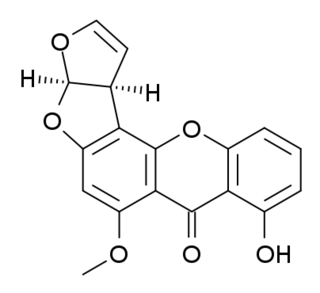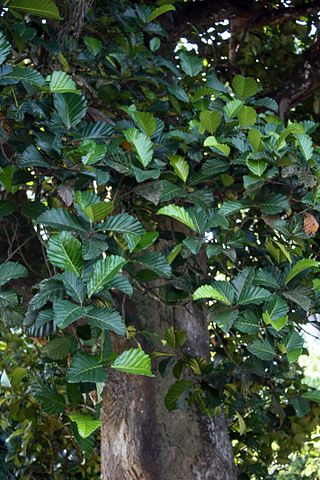
Fumonisin B2 is a fumonisin mycotoxin produced by the fungi Fusarium verticillioides and Aspergillus niger.

Sterigmatocystin is a polyketide mycotoxin produced by certain species of Aspergillus. The toxin is naturally found in some cheeses.

Spirotryprostatin B is an indolic alkaloid found in the Aspergillus fumigatus fungus that belongs to a class of naturally occurring 2,5-diketopiperazines. Spirotryprostatin B and several other indolic alkaloids have been found to have anti-mitotic properties, and as such they have become of great interest as anti-cancer drugs. Because of this, the total syntheses of these compounds is a major pursuit of organic chemists, and a number of different syntheses have been published in the chemical literature.

Artocarpus nobilis, the Ceylon breadfruit, is a tree species in the family Moraceae. It is endemic to south western regions of Sri Lanka. It is known as "Wal dhel - වල් දෙල්", "Baedi dhel - බැදි දෙල්" or as "Hingala dhel - හිංගල දෙල්" by local people.

Prenylated flavonoids or prenylflavonoids are a sub-class of flavonoids. They are widely distributed throughout the plant kingdom. Some are known to have phytoestrogenic or antioxidant properties. They are given in the list of adaptogens in herbalism. Chemically they have a prenyl group attached to their flavonoid backbone. It is usually assumed that the addition of hydrophobic prenyl groups facilitate attachment to cell membranes. Prenylation may increase the potential activity of its original flavonoid.

A xanthonoid is a chemical natural phenolic compound formed from the xanthone backbone. Many members of the Clusiaceae contain xanthonoids.
Glyceollins are a family of prenylated pterocarpans found in ineffective types of nodule in soybean in response to symbiotic infection.
Aspergillus sydowii is a pathogenic fungus that causes several diseases in humans. It has been implicated in the death of sea fan corals in the Caribbean Sea.

Fumitremorgins are tremorogenic metabolites of Aspergillus and Penicillium, that belong to a class of naturally occurring 2,5-diketopiperazines.

Notoamides are bio-active isolates of marine Aspergillus.

Stephacidin A and B are antitumor alkaloids isolated from the fungus Aspergillus ochraceus that belong to a class of naturally occurring 2,5-diketopiperazines. This unusual family of fungal metabolites are complex bridged 2,5-diketopiperazine alkaloids that possess a unique bicyclo[2.2.2]diazaoctane core ring system and are constituted mainly from tryptophan, proline, and substituted proline derivatives where the olefinic unit of the isoprene moiety has been formally oxidatively cyclized across the α-carbon atoms of a 2,5-diketopiperazine ring. The molecular architecture of stephacidin B, formally a dimer of avrainvillamide, reveals a complex dimeric prenylated N-hydroxyindole alkaloid that contains 15 rings and 9 stereogenic centers and is one of the most complex indole alkaloids isolated from fungi. Stephacidin B rapidly converts into the electrophilic monomer avrainvillamide in cell culture, and there is evidence that the monomer avrainvillamide interacts with intracellular thiol-containing proteins, most likely by covalent modification.

(-)-Versicolamide B and (+)-Versicolamide B are spiroindole alkaloids isolated from the fungus Aspergillus that belong to a class of naturally occurring 2,5-diketopiperazines. The versicolamides are structurally complex spiro-cyclized versions of prenylated cyclo(L-Trp-L-Pro) derivatives which possess a unique spiro-fusion to a pyrrolidine at the 3-position of the oxindole core together with the bicyclo[2.2.2]diazaoctane ring system. While (-)-versicolamide B was isolated from the marine fungus Aspergillus sp. the enantiomer (+)-versicolamide B was isolated from the terrestrial fungi Aspergillus versicolor NRRL. The total asymmetric syntheses of both enantiomers have been achieved and the implications of their biosynthesis have been investigated.

Aspergillusenes are a group of chemical compounds first isolated from a strain of sea fan-derived fungus Aspergillus sydowii. They are sesquiterpenes of the bisabolane-type.
Penicillium sacculum is an anamorph species of fungus in the genus Penicillium which produces the xanthone 1-hydroxy-3-methoxy-6-sulfo-8-methylxanthone. Penicillium sacculum was isolated from the halophyte plant Atriplex
Aspergillus qinqixianii is a species of fungus in the genus Aspergillus which has been isolated from desert soil from the Taklimakan desert in China. It is from the Nidulantes section. Aspergillus qinqixianii produces asteltoxin, asperthecin, emericellin, 2-ω-hydroxyemodin, shamixanthones, terrein, curvularin and dehydrocurvularin.
Aspergillus stella-maris is a species of fungus in the genus Aspergillus. It is from the Nidulantes section. The species was first described in 2008. A. stella-maris has been reported to produce emericellin and shamixanthone. It has star-shaped ascospores.
Aspergillus chinensis is a species of fungus in the genus Aspergillus. It is from the Nidulantes section. The species was first described in 2014. It has been reported to produce shamixanthones and varitriol.
Aspergillus filifer is a species of fungus in the genus Aspergillus. It is from the Nidulantes section. The species was first described in 2008. It has been reported to produce shamixanthones and varitriol.

Aspergillus stellatus is a species of fungus in the genus Aspergillus. It is from the Nidulantes section. The species was first described in 1934. It has been isolated from soil in Panama and seeds in India. It has been reported in human infections. It has been reported to produce aflatoxin B1, ajamxanthone, shamixanthone, tajixanthone, tajixanthone hydrate, tajixanthone methanoate, 19-O-methyl-22- methoxypre-shamixanthone, pre-shamixanthone, 15- acetyltajixanthone hydrate, andibenin A, andibenin B, andibenin C, andelesin A, andelesin B, anditomin, arugosin A, arugosin B, arugosin D, asperthecin, astellatol, asteltoxin, desferritriacetylfusigen, dihydroterrein, emervaridione, varioxiranediol, epiisoshamixanthone, ophiobolin C, ophiobolin G, ophiobolin H, ophiobolin K, evariquinone, 2-Furanoic acid, islandicin, isoemericellin, kojic acid, 2-Methoxy-6-(3,4-dihydroxy-hepta-1,5-dienyl)benzyl alcohol, najamxanthone, radixanthone, shahenxanthone, penicillin G, shimalactone A, siderin, stellatic acid, stellatin, stromemycin, terrein, variecoacetal A, variecoacetal B, variecolactone, variecolin, varioxirane, varixanthone, varitriol, and varioxranol A-G.

Ajamxanthone is a chemical compound which is produced by the fungus Aspergillus stellatus. Ajamxanthone forms yellow needles. Its synonyms are (+)-ajamxanthone and CTK8I3902.













